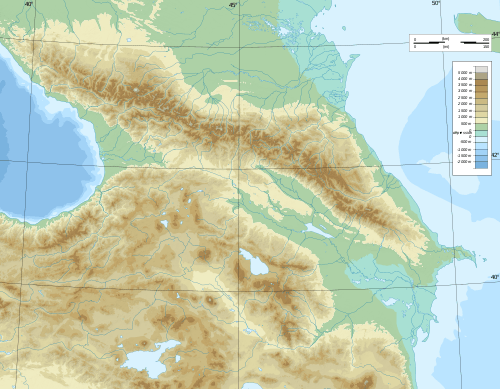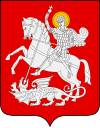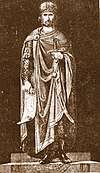Battle of Didgori
| Battle of Didgori | |||||||
|---|---|---|---|---|---|---|---|
| Part of the Georgian-Seljuk wars, Great Turkish Invasion | |||||||
| |||||||
| Belligerents | |||||||
| Artuqids, Eldiguzids, Mazyadids, Shaddadids, Emirate of Tiflis, Shah-Armens. | Alans, Kipchaks and Frankish mercenaries. | ||||||
| Commanders and leaders | |||||||
|
Ilghazi (WIA) Dubays II |
David IV Prince Demetrius | ||||||
| Strength | |||||||
|
modern Georgian est.: other sources: contemporary chronicles: 400,000-600,000 or 800,000 [4][5][6] |
Total: 55,600[5][6] | ||||||
| Casualties and losses | |||||||
|
Killed: 400,000[7] Captured: 50,000[7] | Unknown | ||||||
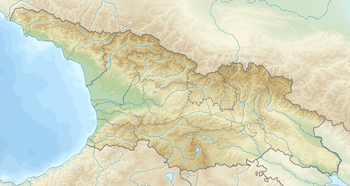 Battle of Didgori Location of Didgori valley in Georgia with present-day administrative borders. | |||||||
The Battle of Didgori was fought between the armies of the Kingdom of Georgia and the Great Seljuq Empire at the narrow place of Didgori, 40 km west of Tbilisi, on August 12, 1121. The large Muslim army, under the command of Ilghazi ibn Artuq was unable to maneuver, and suffered a devastating defeat due to King David IV of Georgia’s effective military tactics.
The battle at Didgori was the culmination of the entire Georgian-Seljuk wars, and led to the Georgians’ reconquest of Tbilisi in 1122. Soon after that David moved the capital from Kutaisi to Tbilisi. The victory at Didgori inaugurated the medieval Georgian Golden Age and is celebrated in the Georgian chronicles as a (Georgian: ძლევაჲ საკვირველი, dzlevay sakvirveli; lit. the "miraculous victory"). Modern Georgians continue to remember the event as an annual September festival known as Didgoroba ("[the day] of Didgori").[9][10]
Prelude
The Kingdom of Georgia had been a tributary to the Great Seljuq Empire since the 1080s. However, in the 1090s, the energetic Georgian king David IV was able to exploit internal unrest in the Seljuq state and the success of the Western European First Crusade against Muslim control of the Holy Land, and established a relatively strong monarchy, reorganizing his army and recruiting Kipchak, Alan, and even Frankish mercenaries to lead them to the reconquest of lost lands and the expulsion of Turkish raiders. David's battles were not, like those of the Crusaders, part of a religious war against Islam, but rather were a political-military effort to liberate Caucasus from the nomadic Seljuks.
David renounced the tribute to the Seljuqs in 1096/7, and put an end to the seasonal migrations of the Turks into Georgia. Following the annexation of Kingdom of Kakheti, in 1105, David routed a Seljuk punitive force at the Battle of Ertsukhi, leading to momentum that helped him to secure several key fortresses in a series of campaigns from 1103 to 1118.
Georgia having been at war for the better part of twenty years, needed to be allowed to become productive again. To strengthen his army, King David launched a major military reform in 1118–1120 and resettled several thousand Kipchaks from the northern steppes to frontier districts of Georgia. In return, the Kipchaks provided one soldier per family, allowing King David to establish a standing army in addition to his royal troops (known as Monaspa). The new army provided the king with a much-needed force to fight both external threats and internal discontent of powerful lords.
Starting in 1120, King David began a more aggressive policy of expansion, penetrating as far as the Araxes river basin and the Caspian littoral, and terrorizing Muslim traders throughout the South Caucasus. By June 1121, Tbilisi had actually been under a Georgian siege, with its Muslim élite being forced into paying a heavy tribute to David IV.[11] The resurgence of Georgians’ military energies, as well as his demands for tribute from the independent city of Tbilisi brought about a coordinated Muslim response. In 1121, Sultan Mahmud b. Muhammad (c.1118–1131) declared a holy war on Georgia.
Deployment and order of battle
The Muslim coalition

Both Georgian and Islamic sources testify that, on the complaints of the Muslim merchants of – Tbilisi, Ganja and Dmanisi – Sultan Mahmud II of Baghdad (r. 1118-1131) sent an expedition into Georgia under command of Ilghazi ibn Artuq of Mardin, whose hegemony in the Middle East and authority among the Muslims was indisputable. After pillaging the County of Edessa and defeat of Roger of Antioch at the battle of Ager Sanguinis in 1119, the reputation of Ilghazi as a great military commander and champion of Muslims against Christians spread far and wide.
After this victory Ilghazi made truce with the Crusaders and went to north towards Armenia at invitation of Sultan’s brother Toghrul, ruler of Arran, to join a Muslim coalition against Christian Georgians and lead the coalition’s army,[12] in which his vassal Tughan-Arslan lord of Arzen, Bidlis and Dvin; the Mazyadid Dubays II ibn Sadaqa of Al Hillah and the Toghrul; lord of Arran and Nakhichevan, with his atabeg Kun-Toghdi all took part.
The size of the Muslim army is still a matter of debate, with numbers ranging from a fantastic 600,000 men (as given by Walter the Chancellor and Matthew of Edessa) to 400,000 (Sempad Sparapet's Chronicle), while estimates of modern Georgian historians vary between 100,000 and 250,000 men. Although the higher numbers are exaggerated, all sources indicate that the Muslims made massive preparations and vastly outnumbered the Georgians.
In mid-summer 1121, the Muslim troops advanced along various routes, with part of them passing the provinces of Erzerum and Kars, while Sultan Toghrul ibn Muhammad moved through Ganja and Tughan-Arslan the "Hunchback" marched from Dvin. As the Georgian king was well aware of the coalition’s plans, he decided to exclude one of the coalition leaders. In the first half of 1121, the Georgians twice attacked Seljuks on the territory of Emirate of Ganja and massacred them, as a consequence, the ruler of Arran was no longer able to participate in the campaign.
Ilghazi was aware about the defeat of his main ally, but he continued his march. In July 1121, the army of Ilghazi entered Georgian territory. According to Al-Fāriqī, Ilghazi selected the route from Kars to Javakheti and Trialeti to reach Tbilisi, where he could camp, rest and then act against the Georgians. The Muslim army under the overall command of Ilghazi entered the valley of Trialeti in eastern Georgia and encamped in the vicinities of Didgori and Manglisi in 10 August 1121,[11] about a day’s march from Tbilisi.
Little is known of Ilghazi's exact battle plan or course of action and order of battle other than the commonly suggested deployment of large numbers of light missile troops, particularly archers and light cavalry in the vanguard to harass the enemy lines while the bulk of the army remained behind them in orderly battle formation. It is suggested that Ilghazi's vanguard approached David's army and reported back about a much smaller force than expected, which might have raised Ilghazi's confidence enough to not expect any surprise. It is also claimed that the Seljuq light cavalry rode in front of the Georgians and started to shoot and taunt them which was received with little to no effect on their morale. There is no evidence of heavy cavalry present on Ilghazi's side or any type of cavalry which could have matched the Georgian counterpart.
The Georgian army
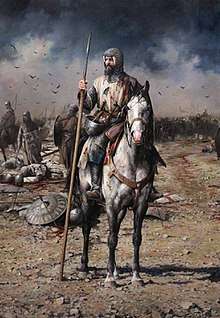
On the other side the Georgians were facing a significantly superior foe in terms of numbers, but had the strategic as well as tactical advantage. The Georgians were well aware of the Muslim preparations and took necessary precautions. In 1118, after successful completion of David IV's military reform, a royal guard (known as Monaspa) of about 5000 horsemen was formed. The Georgian army of 56,000 men included 500 Alans, about 200 Franks and 15,000 Kipchaks.
The smallest formations would be equivalents of nowadays squads and platoons, then a "group of 100" and so forth all led by servants of higher status and different rank. The most crucial and core component was the Monaspa guard or royal guard which consisted of 5,000 well trained and heavily armed, mounted warriors which would be used as shock cavalry together with the nobility. The Crusaders, the Kipchak cavalry and a small portion of infantry were deployed in the center of the Georgian army around the king's banner while the rest were equally split in two major wings initially out of sight for the Seljuqs. Each formation was headed by a great and dense line of horsemen. The heavy cavalry would smash into the enemy ranks with their lances joined by the infantry which would entangle the Seljuq main body in fights while the cavalry was to regroup and carry out repeated attacks till the enemy broke. At the sign of collapse David would then send forward his Kipchak cavalry. Initially the king and all his entourage stayed in the center but would immediately switch to their respective positions when the battle commenced. During battle David IV would assume command over his army's left wing, while Demetrius was leading the right.
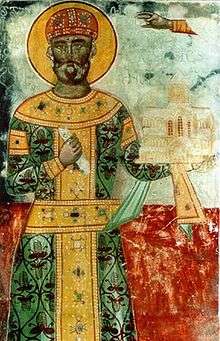
According to the French knight and historian Walter the Chancellor, before heading off to battle, King David inspired his army with these words:
| “ | “Soldiers of Christ! If we fight bravely for our Faith, we will defeat not only the devil’s servants, but the devil himself. We will gain the greatest weapon of spiritual warfare when we make a covenant with the Almighty God and vow that we would rather die for His love than escape from the enemy. And if any one of us should wish to retreat, let us take branches and block the entrance to the gorge to prevent this. When the enemy approaches, let us attack fiercely!” | ” |
Kipchaks
Their relations with Cumans-Kipchaks seem to have been generally peaceful. Moreover, the Georgian politicians of that time saw the Kipchaks as potential allies against the Seljuk conquests. According to Georgian chronicles, Georgians knew about the Kipchaks good fighting skills, their bravery, and the enormous human resources that they had."[14] After the victories of the Rus' Grand Prince Vladimir II Monomakh in 1109, Kipchaks commanded by Otrok Khan,[15][16] known in Georgia as Atrak'a, son of Sharagan (i.e. Sharukan), fled to Georgia with some 40,000 followers, received baptism and entered the service of the Georgian king David IV. The Georgian-Kipchak alliance was facilitated by David's earlier marriage to the Khan's daughter who received the name Gurandukht. Kipchaks were outfitted by the crown and were granted lands to settle. In turn, the Kipchaks provided one soldier per family, allowing King David to establish a standing army in addition to his royal troops.
Franks
The participation of Frankish soldiers in the battle of Didgori is reported in two sources: one by a 12th century Armenian historian, Matthew of Edessa, who mentions 100 Franks,[17] and the other by Walter the Chancellor, according to whom David used 200 Frankish soldiers deployed ahead of his armies as a striking force against the enemy.[18]
There is no exact information whether they were auxiliary troops sent by the prince of Antioch or king Baldwin II of Jerusalem,[19] or simply mercenaries. However, as both Franks and Georgians had one common enemy, the Muslims, it can be argued that the Frank soldiers were allies rather than mercenaries. It's supposed that Crusaders arrived to Georgia through Constantinople because the territory between Antioch and Georgia was occupied by the Seljuks.
The battle
King David could not allow Ilghazi to unite with the Tbilisi Muslims, so he decided to intercept him on his way there. He used a strategy of surprise and to entice the enemy step-by-step into a trap. He chose a mountainous and woodland area near the Didgori Mountain range, situated between Manglisi and Tbilisi, to attack. On August 11, 1121, King David led his army along the Nichbisi valley from the ancient capital of Mtskheta and divided his troops into two parts, one under his personal command and the other smaller group under his son Demetrius I, hidden in reserve behind the nearby heights with orders to attack the flank at a given signal.
The course of the battle is differently related in the contemporaneous historical records. According to the Arab chronicler Ibn al-Athir, David sent a small Kipchak detachment of his men in order to simulate negotiation. The Muslims thought that the small detachment had left the Georgian army for seeking protection, so the Muslims did not regard them as a threat. Meanwhile, the Georgians successfully managed to deploy a large portion of their force where they would almost encircle the enemy in a pincer movement. Their opponents remained unaware of such activities. Upon approaching the Seljuq leaders, the deserters using the self-confidence of the Muslims to their advantage attacked them with arrows killing every Seljuq commander in sight and others who were attending the meeting.
While this was going on David ordered a frontal attack on the enemy vanguard with his crusader knights which not only devastated the enemy's forward lines but also entangled the Seljuq archers in close combat, effectively taking out a crucial component of Ilghazi's force. This trick resulted in chaos and panic among the Muslims. The Georgians then began to quickly advance on the flanks from the western side of the mountain in full formation. Ilghazi ibn Artuq and his on-in-law both survived the attack on the vanguard but were severely injured during the fight and withdrew from the battlefield, leaving the Seljuq army virtually leaderless.
.jpg)
The majority of his commanders were either injured or killed, which caused confusion and probably resulted in a lack of adequate response to the chaotic situation. King David didn't hesitate and personally led the Georgian right flank, ordering his heavy cavalry to ride straight into the seemingly disorganised Seljuk left flank, which was trying to reinforce the vanguard. Having the advantage of moving downhill, the charge of the Georgian cavalry proved very effective.
Almost simultaneously the left wing, under the command of David's son Demetrius, struck the Seljuk right flank also with heavy cavalry. When the Georgian infantry joined the fight, the Seljuq troops started to panic and retreated en masse through the huge gap in their army's rearguard, which wasn't engaged in the battle. This provoked large numbers of uninvolved Seljuq troops to flee as well, causing a massive rout, while their vanguard was completely annihilated.
"Terrible and savage slaughter of the enemy troops ensued and the [enemy] corpses filled up the rivers and covered all valleys and cliffs."
With the Kipchaks joining in, the final remnants of Seljuq resistance crumbled and joined the rout. The battle was decided within three hours with the Seljuq army overrun leaving a very large number of dead, injured, prisoners and booty. Fleeing remaints were constantly pursued and run down for several days so that they wouldn't have time or opportunity to regroup or commence any other move.
Aside from those accounts, it has also been suggested that confronted by a vanguard of the large invading force, David had to rely on the advantages the nearby terrain offered to disguise his troop movements. The Seljuk cavalry was provoked or tricked into a relatively narrow pass where they probably had not much room to maneuver. As these were cut off from the rest of Ilghazi's army, the Georgians were easily able to take them out with spears, pikes, and light infantry using bows and javelins. The rest of the coalition army was probably forced to climb slopes to attack the Georgian army's main body, while being constantly struck at the flanks by heavy cavalry. After a while, those tactics broke the fighting will of the Muslim army, which was soon routed. Ilghazi reportedly received an injury to his head when a hundred crusaders managed to break through his lines rushing towards the Seljuq command banner.[20]
Aftermath
The numbers of Seljuks fleeing the field was reportedly so large that the Georgian cavalry was taking scores of prisoners for several days. As a result, the Georgians were able to liberate the entire region from Muslim influence and even contest territories within the Seljuq Empire, which at that point was left almost defenceless. The captured Seljuqs would serve for David's ambitions to rebuild his kingdom.[21]
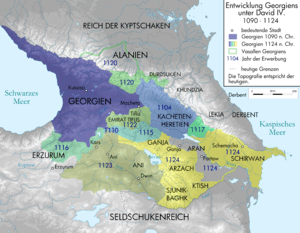
The unification of Georgia and the elimination of Muslim authority was completed in the year following the battle at Didgori. David laid siege to and captured the city of Tbilisi, which for nearly four hundred years had been an Islamic town. Five hundred citizens were tortured to death, and much of the city burned. Tbilisi became a royal town, the capital of Georgia, "for ever an arsenal and capital for his sons."
The medieval sources emphasize David’s acts of revenge against the Muslims of Tbilisi. However, the Arab historian al-'Ayni (1360–1451), who utilizes sources, some of which have not survived, admits that the city was pillaged but says that the Georgian king eventually showed patience and "respected the feelings of the Muslims."[11][21] A well-educated man, he preached tolerance and acceptance of other religions, abrogated taxes and services for the Muslims and Jews, and protected the Sufis and Muslim scholars.
Having his forces exhausted and being wounded Ilghazi himself, he returned to Mardin in a devastated condition. The Didgori battle helped the Crusader states, which had been under the pressure of Ilghazi’s armies. The weakening of the main enemy of the Latin principalities was beneficial for the Kingdom of Jerusalem under King Baldwin II.
References
- ↑ Rogers, Clifford J, Kelly DeVries, and John France. Journal of Medieval Military History. Woodbridge, UK: Boydell Press, 2013. Print.
- ↑ Golden, Peter B. Turks And Khazars. Farnham, England: Ashgate/Variorum, 2010. Print.
- ↑ Lortkipanidze, Mariam and B. G Hewitt. Georgia In The XI-XII Centuries. Tbilisi [Georgian S.S.R.]: Ganatleba Publishers, 1987.
- ↑ Mikaberidze, Alexander. Conflict And Conquest In The Islamic World. Print.
- 1 2 Alexander Mikaberidze, Miraculous Victory:’ Battle of Didgori, 1121, Published: May 14, 2008;"The size of the Muslim army is still a matter of debate with numbers ranging from a fantastic 800,000 men (“Bella Antiochena”, Galterii Cancelarii), 600,000 Turks (Matthew of Edessa) to 400,000 (Smbat Sparapet’s Chronicle) while the estimates of modern Georgian historians vary between 100,000-250,000 men."
- 1 2 Nomads in the Sedentary World, p. 47, at Google Books
- 1 2 3 4 Смбат Спарапет / Летопись / пер. А. Г. Галстяна — Ер. Изд-во «Айастан». 1974 г. Царь Грузии Давид, сын Декая, сын Багарата, сын Георге, собрал все своё войско, пригласил на помощь также 40000 кипчаков, 18000 аланов, 10000 армян, 500 франков, людей храбрых и воинственных. Вот с таким количеством людей он (Давид) выступил в бой. Это был страшный бой. С божьей помощью победили христиане. Они истребили свыше 400000 и взяли в плен 50000 человек. Султан Мелек и Хази позорно обратились в бегство, а Давид победоносно и радостно возвратился обратно
- ↑ Ronald Grigor Suny / The Making of the Georgian Nation / Indiana University Press, 1994. - p. 36 (418) ISBN 0253209153, 9780253209153 On August 12, 1121, the Georgians and their Armenian, Qipchak, Osetin, and Shirvan allies advanced and attacked the Muslims unexpectedly near Didgori, achieving what in Georgian history is known as dzlevai sakvir- veli, the "wonderful victory."
- ↑ Suny, Ronald Grigor (1994). The Making of the Georgian Nation. Indiana University Press. p. 36. ISBN 0-253-20915-3.
- ↑ Virgil, et al. Georgica. Heidelberg: C. Winter, 1985. Print.
- 1 2 3 Minorsky, Vladimir (1993). "Tiflis". In Houtsma, M. Th.; van Donzel, E. E. J. Brill's First Encyclopaedia of Islam, 1913–1936. Brill. p. 755. ISBN 90-04-08265-4.
- ↑ Venning, Timothy; Frankopan, Peter (2015-05-01). A Chronology of the Crusades. Routledge. ISBN 9781317496427.
- ↑ "FERRER –DALMAU: El espíritu del jinete", Diario YA
- ↑ (in Georgian) The Georgian Chronicles about the Cuman - Kipchak resettlement in Georgia at the TITUS Project.
- ↑ Anatoly Michailovich Khazanov, André Wink (2001), Nomads in the Sedentary World, pp. 46-8. Routledge, ISBN 0-7007-1369-7.
- ↑ Denis Sinor (1990), The Cambridge History of Early Inner Asia, pp. 181,280. Cambridge University Press, ISBN 0-521-24304-1.
- ↑ Matteos Urhayetsi 1869: 438
- ↑ Galterius 1896: 113-114
- ↑ Soltes, Ori Z. National Treasures Of Georgia. London: Philip Wilson Publishers, 1999. Print.
- ↑ Rogers, Clifford J, Kelly DeVries, and John France. Journal of Medieval Military History. Woodbridge, UK: Boydell Press, 2013. Print.
- 1 2 (in Georgian) Javakhishvili, Ivane (1982), k'art'veli eris istoria (The History of the Georgian Nation), vol. 2, pp. 184-187. Tbilisi State University Press.
Further reading
- Mikaberidze, Alexander (May 14, 2008). "'Miraculous Victory:' Battle of Didgori, 1121". Armchair General.
- Fähnrich, Heinz (1994). "Die Schlacht am Didgori". Georgica (in German). 17: 33–39.
